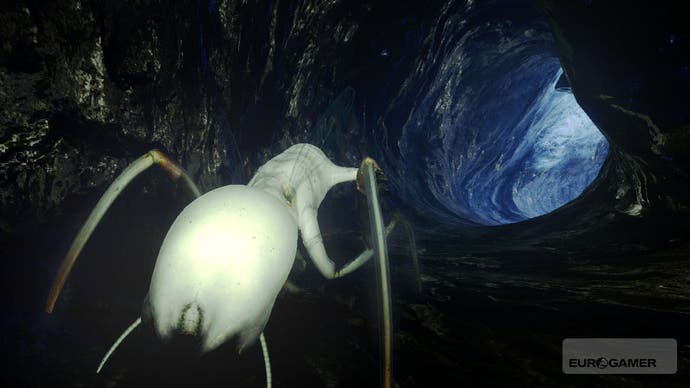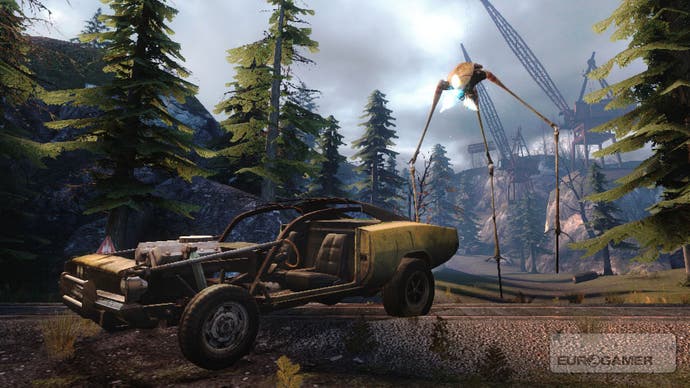Half-Life 2: Episode Two
What next in the parade of constant obstacles?
Episode Two kicks off with Gordon Freeman climbing out of the twisted metal of a smoking train wreck. Is that a metaphor for Episode One? It's been both fun and slightly disappointing to rib Valve for the way in which its bold episodic experiment 'hit the buffers' as soon as it began in May of last year. 'Fun' in that it's oh-so-typical of Valve to be so far off with its release date predictions for the follow-up again that you can't help but give them a cheeky wink every time a new date emerges. It's disappointing because, well, we really wanted to believe that they could do what no other FPS developer had ever done and turn out three episodes of a triple-A game in the space of a year, as was the original plan.
But when, over Tacos, you hear Robin Walker's admission that the reason Episode Two slipped was simply because "it wasn't good enough", delaying it was clearly the right thing to do.
Maybe, deep down, the reaction to Episode One was just as significant in the decision to move the goal-posts. "Too short!" said some people. "Too constrained!" said others. "Not epic enough!" said another made up person. For the first time in the company's history it released a headline product with an average review score outside of the '90s, and its own online stat tracking system on Steam found that a worrying proportion of its devoted audience switched off long before the end. For a game as short as Episode One, that's a slap in the face.
This Vortal Coil

Episode Two is the product of a developer that wants to make damned sure you see this one all the way to its frantic conclusion. Clocking in at a fat-free seven hours, it's about 50 per cent longer than the first one, i.e. not far short of the kind of gameplay hours offered by several full-priced offerings recently. You certainly won't feel short-changed - and wouldn't even if it were being sold separately. After the claustrophobic confines that characterised your escape from City 17, this feels like a dramatic release, underlined no end by the menacing vistas and spectacular 'Portal storms' that threaten all sorts of unspoken havoc in the near future.
Climbing out of the wreckage, your journey picks up precisely where Episode One left off. Emerging from the twisted carriage, you're quickly reunited with your faithful partner Al, who seems to have - perhaps predictably - escaped entirely unscathed from what appears to be a pretty devastating collision. With an all-important code in Al's possession, she knows all-too-well that the Combine forces are tracking them and will be on their tail in a matter of minutes if they don't push on to the White Forest. And so it begins again in familiar fashion. She hands you the faithful gravity gun and you head underground and set about your silent extermination of anything that gets in your way.

As with Episode One, it's quite clear that consistency has been rigorously adhered to. Despite it being almost three years since Half-Life 2's release, there's nothing jarringly new that would make it feel out of place with its parent game. So, yes, it's all very familiar: the same beloved weapons load-out, roughly the same set of enemies, and a series of memorable, tense situations and set-pieces to deal with. This is obviously a good and a bad thing in many ways. Good in that Half-Life 2 was a landmark 10/10 classic, and one that has withstood the rigours of next-gen technological progress (it was, after all, one of the first truly next-gen games). In my book, anything that expands and progresses those adventures and its excellent storyline is very much a positive thing.
Riding shotgun
On the other hand, by being so tethered to the look and feel of the Half-Life 2 story and universe, that familiarity doesn't exactly breed contempt in Episode Two, but there's a persistent lack of the 'wow' factor which infused almost every minute of the parent game. We've flinched at the approaching leap of a headcrab. We've set fire to headcrab zombies. We've sliced them in two with saw-blades. We've whipped grenades from the mitts of 'Zombines' and chucked them back in their twisted faces. We've sat goggle-eyed at the majesty of the War of the Worlds-esque Striders as they suck the very matter out of existence. We've admired the advances of co-op AI and the effortless expressiveness in the facial animation of Al, Eli, Magnusson, the G-Man, et al. And all of this is true in Episode Two. It's still utterly brilliant, but you can't escape that this is still very much more of the same. The mechanics are still all there, just as they should be, but if you approach Episode Two expecting some sort of magical new world, then you'll come away disappointed. This isn't the new next-gen or anything, but a refinement and steady progression of one of the best first-person shooters ever made.

The real thrill of Episode Two comes, therefore, not from dramatic new gameplay concepts or originality (that's Portal's job) but from fleshing out the game's storyline - its twists, turns, and surprises. But without completely ruining it for everyone considering playing it, discussion of key events would utterly destroy a significant reason for playing it, which kind of makes writing a review of the game a slightly tricky ask. On that level, what I will suggest is that that few - if any - people will be disappointed. There are several absolutely shocking events which amply demonstrate how integral storytelling is to playing a Half-Life game.

